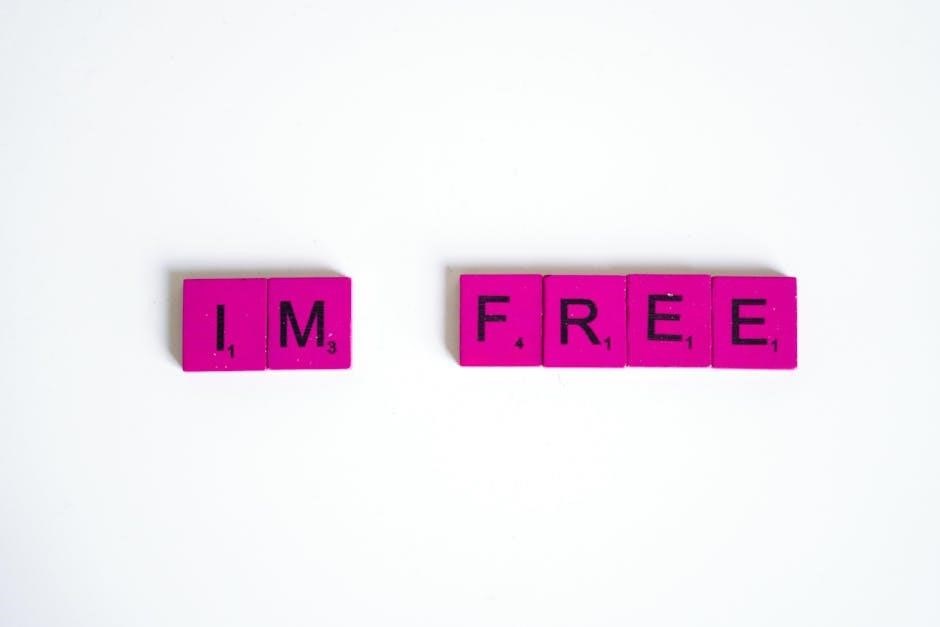Communication boards are essential tools for individuals with speech challenges, offering visual aids like free printable PECs pictures to enhance expression and understanding in various settings.
1.1 What Are Communication Boards?
Communication boards are tools designed to facilitate interaction for individuals with speech or language challenges. They typically consist of a display of symbols, images, or words that users can point to or exchange to convey messages. These boards can be customized to meet individual needs, offering a flexible means of expression. Free printable PECs pictures, such as those found online, are often used to create these boards, providing visual aids that support effective communication. They are widely used in educational, therapeutic, and home settings to empower individuals with autism or other communication difficulties, ensuring their voices are heard and understood.
1.2 The Role of PECs in Communication
PECs, or Picture Exchange Communication Symbols, play a vital role in facilitating communication for individuals with speech challenges. These visual aids enable users to convey needs, wants, and ideas by exchanging images. Free printable PECs pictures are widely used, especially for autism, as they provide a structured and accessible way to initiate interactions. The system teaches functional communication skills, starting with simple exchanges and progressing to complex sentences. PECs are customizable, allowing users to tailor images to their specific needs. This approach fosters independence, reduces frustration, and enhances overall communication effectiveness in various settings, making it a popular choice for educators, caregivers, and therapists.
1.3 Importance of Visual Aids in Communication
Visual aids, such as free printable PECs pictures, play a crucial role in communication by providing clear, tangible representations of ideas and needs. These tools are especially beneficial for individuals with autism or other communication challenges, as they help bridge gaps in verbal expression. By using visual cues, users can convey their thoughts more effectively, reducing frustration and enhancing understanding. The availability of free, downloadable resources like PECs cards ensures accessibility for diverse settings, including homes, classrooms, and therapy sessions. Customizable options further tailor these aids to individual needs, making communication more intuitive and empowering for all users.
Benefits of Using Free Printable PECs Pictures

Free printable PECs pictures offer a cost-effective, accessible solution for communication, aiding individuals with autism and speech challenges while providing customization options for personalized needs.
2.1 Cost-Effective Solution for Communication
Free printable PECs pictures provide an affordable and accessible way to create communication boards, making them a cost-effective solution for individuals and educators. These resources eliminate the need for expensive materials, allowing users to download and print high-quality images at no cost. Websites like Noodle Nook and PECs UK offer free templates and symbols, ensuring that communication aids are within reach for everyone. This accessibility empowers individuals with autism and other speech challenges to express themselves without financial barriers. The availability of free PECs cards and printables has revolutionized communication support, offering a budget-friendly alternative to traditional methods.
2.2 Accessibility for Individuals with Autism
Free printable PECs pictures and communication boards are invaluable for individuals with autism, providing visual aids that support non-verbal communication. These tools are customizable to meet specific needs, ensuring accessibility for those with varying abilities. The availability of free resources online makes them accessible to families and educators, reducing financial barriers. Visual cues help individuals with autism express their needs effectively, fostering independence and confidence. These communication boards are widely used in educational and therapeutic settings, offering a practical solution for enhancing communication skills. Their adaptability ensures they can be tailored to individual preferences, making them a versatile tool for daily interactions.
2.3 Customization Options for Individual Needs
Free printable PECs pictures offer extensive customization options, allowing users to tailor communication boards to specific needs. Websites provide templates that can be edited to include personal preferences, such as favorite activities or daily routines. Software tools enable users to add or remove images, adjust layouts, and incorporate core vocabulary. This flexibility ensures that communication boards are relevant and effective for individuals with diverse abilities. For example, boards can be designed for specific settings like classrooms or homes, or focused on emotions and behaviors. High-quality, printable images ensure clarity and engagement, making customization both practical and impactful for enhanced communication outcomes.
How to Create a Communication Board
Creating a communication board involves selecting appropriate images, designing a user-friendly layout, and printing the materials. Utilize free PDFs and templates for efficient assembly.
3.1 Choosing the Right Images for PECs
Selecting appropriate images for PECs is crucial for effective communication. Use clear, high-quality visuals that are relevant to the individual’s needs and context. Ensure images are unambiguous and easily recognizable. Consider the environment where the PECs will be used, such as home or school, to tailor the images accordingly. Free printable PECs pictures from reliable sources like PECs UK or educational websites can provide a wide range of options. Test the images with the user to confirm understanding and effectiveness. This step ensures the communication board is both functional and user-friendly, promoting successful interaction and expression.
3.2 Designing the Layout of the Board
Designing the layout of a communication board requires careful consideration to ensure clarity and ease of use. A well-organized grid system with high-contrast colors can enhance visibility. Place frequently used images in accessible locations, while less common ones can be positioned toward the edges. Ensure spacing is adequate to avoid overcrowding, making it easier for users to navigate. Customization is key; tailor the layout to suit individual needs, such as autism-specific requirements. Incorporate visual cues like arrows or borders to guide the user’s eye. For example, core vocabulary boards often feature a consistent layout, while activity-specific boards may prioritize relevant images. This structured approach ensures effective communication and user independence.
3.3 Printing and Assembling the Board
Printing and assembling a communication board involves selecting high-quality paper or cardstock for durability. Use a printer with vibrant colors to ensure clarity of free printable PECs pictures. Laminate the images or use laminating sheets for protection. Arrange the pictures logically, grouping related symbols together for easy access. Secure the images to the board using adhesive or Velcro for flexibility. Ensure the layout is user-friendly, with adequate spacing to avoid overwhelming the individual. Finally, test the board to ensure all elements are functional and meet the user’s needs. Proper assembly ensures the board remains a practical and effective communication tool.

Tools and Resources for Printable PECs

Find free PECs templates on websites like PECs UK, offering downloadable images and symbols. Use design tools like Canva or Boardmaker for customization, ensuring high-quality visuals for communication boards.
4.1 Websites Offering Free PECs Templates
Several websites provide free PECs templates, making it easier to create communication boards. Teachers Pay Teachers (TPT) offers a variety of printable PECs cards and visual aids. The PECs UK website also provides sample cards that can be downloaded and printed. Additionally, platforms like Noodle Nook and My PECs offer free communication boards designed for individuals with autism. These resources include core vocabulary boards, activity-specific templates, and emotion expression boards. They are cost-effective and easily accessible, ensuring everyone can benefit from visual communication tools. These websites are invaluable for educators, parents, and therapists seeking high-quality, printable materials.
4.2 Software for Customizing Communication Boards
Several software tools are available for customizing communication boards, offering flexibility and creativity. Canva and Adobe Spark provide user-friendly interfaces for designing boards with free templates. Boardmaker and SymbolStix are popular for creating AAC materials, including PECs. Google Slides is another versatile option, allowing collaboration and easy sharing. These tools enable users to personalize layouts, add symbols, and incorporate high-quality images. Many platforms also offer free resources, such as Teachers Pay Teachers and PECs UK, which provide downloadable templates and images. Using these tools ensures communication boards are tailored to individual needs, enhancing their effectiveness in various settings.
4.3 Tips for Finding High-Quality Images
When searching for high-quality images for communication boards, use specific keywords like “free PECs cards” or “free PECs symbols” to find relevant resources. Websites like PECs UK and Teachers Pay Teachers offer reliable options. Ensure images are high-resolution and clear for visibility. Check for copyright-free or royalty-free licenses to avoid legal issues. Preview images before downloading to confirm they match your needs. Additionally, platforms like Google Images and specialized education sites provide diverse options. Always verify the source’s credibility to ensure the images are professional and suitable for communication aids.

Popular Types of Communication Boards
Core vocabulary boards, activity-specific boards, and emotion expression boards are widely used, offering tailored visual aids for diverse communication needs and preferences.

5.1 Core Vocabulary Boards
Core vocabulary boards are foundational tools in communication, providing essential words and phrases for daily interactions. They are widely used in AAC (Augmentative and Alternative Communication) systems, offering a structured approach to expression. These boards typically include high-frequency words and symbols, such as greetings, questions, and basic needs, making them accessible for individuals with limited speech abilities. Free printable PECs pictures often feature core vocabulary, allowing users to create customizable boards tailored to individual needs. Their simplicity and versatility make them invaluable in educational and therapeutic settings, empowering users to communicate effectively and confidently. They serve as a starting point for building more complex communication skills.
5.2 Activity-Specific Communication Boards
Activity-specific communication boards are tailored to particular tasks or events, such as meal planning, classroom activities, or art projects. These boards use free printable PECs pictures to match the context, making communication more relevant and efficient. For example, a cooking board might include images of ingredients or utensils, while a classroom board could feature actions like “raise hand” or “turn in work.” This customization helps individuals focus on the task at hand, reducing confusion and enhancing participation. Websites like Teachers Pay Teachers and PECs UK offer free templates and images for creating these specialized boards, ensuring accessibility for various needs and settings.
5.3 Emotion and Feeling Expression Boards
Emotion and Feeling Expression Boards are designed to help individuals communicate their emotions effectively. These boards use visual aids like free printable PECs pictures to represent feelings such as happiness, sadness, or anger. By providing a clear and accessible way to express emotions, these boards foster emotional intelligence and social interaction. They are particularly useful for individuals with autism or those who struggle with verbal communication. The boards often include a variety of images, from simple facial expressions to more complex emotional states, allowing users to identify and convey their feelings accurately. This tool is invaluable for promoting emotional well-being and understanding in both personal and therapeutic settings.

Using PECs in Different Settings
PECs are versatile tools used in classrooms, homes, and therapy sessions, providing visual support for communication in various environments, with free printable resources enhancing accessibility and effectiveness.
6.1 Implementing PECs in the Classroom

Implementing PECs in the classroom provides students with a structured way to communicate effectively. Teachers can use free printable PECs pictures to create visual aids that support learning and engagement. These tools are particularly beneficial for students with autism or speech challenges, enabling them to express their needs and participate in activities confidently. By integrating PECs into daily routines, educators can foster an inclusive environment where every student has the opportunity to thrive. Customizable communication boards allow teachers to tailor visuals to specific lessons or classroom activities, ensuring relevance and accessibility for all learners.
6.2 Using PECs at Home
Using PECs at home creates a supportive environment for individuals with communication challenges. Families can access free printable PECs pictures online, allowing them to customize boards for daily routines. These visual aids help with mealtime, activities, and emotional expression, fostering independence. Parents can print core vocabulary boards or specific cards for tasks like chores or hobbies. Consistency is key, as it helps individuals adapt and communicate effectively. Free resources like PDFs and templates make it easy to tailor boards to personal needs, ensuring seamless integration into home life and enhancing overall quality of communication.
6.3 PECs in Therapy Sessions
PECs are invaluable in therapy sessions, aiding individuals with speech challenges to express needs and emotions effectively. Therapists use these visual tools to support clients in communicating clearly, fostering confidence and interaction. Free printable PECs pictures, such as core vocabulary and emotion-based boards, are widely used to tailor sessions to individual needs. These resources are cost-effective and easily accessible, making them a popular choice for therapists. By incorporating PECs, therapy sessions become more engaging, helping individuals build communication skills and emotional expression. This approach has proven to enhance therapy outcomes, making PECs a cornerstone in speech and language therapy settings.

Legal and Ethical Considerations
Legal and ethical considerations for communication boards involve ensuring copyright compliance, protecting user privacy, and ethical use of free printable PECs pictures and resources.
7.1 Copyright Issues with PECs Images
Using free printable PECs pictures requires careful consideration of copyright laws. Many images available online are protected by copyright, and using them without permission can lead to legal consequences. While some websites offer free PECs cards, ensure they are licensed for public use or modify them appropriately. Always verify the source and licensing terms to avoid infringement. Respecting intellectual property is crucial, even for educational or therapeutic purposes. Using royalty-free or Creative Commons-licensed images is a safe alternative. Websites like PECs UK often provide free, legally usable resources, ensuring compliance with copyright regulations while supporting communication needs.
7.2 Ensuring Privacy in Communication Aids
Ensuring privacy in communication aids is crucial to protect sensitive information. Use secure storage for digital PECs and limit access to authorized individuals. Regularly update security measures to prevent data breaches. Encrypt sensitive data and ensure compliance with privacy regulations. Avoid sharing personal information without consent. Use anonymous identifiers when necessary. Train users and caregivers on privacy best practices. Implement access controls and audit logs to monitor usage. Protect physical communication boards from unauthorized access. Dispose of outdated materials securely. Prioritize privacy to maintain trust and safety in communication systems. Regular audits and updates help safeguard confidentiality and ensure ethical use of communication aids.
7.3 Ethical Use of Free Resources
Using free printable PECs pictures and communication boards requires ethical consideration. Always respect copyright laws and attribute sources when necessary. Ensure privacy by avoiding sensitive information in shared materials. Verify the terms of use for free resources to comply with licensing agreements. Avoid redistributing paid content without permission. Support creators by promoting their work ethically. This fosters a responsible community, encouraging continued access to valuable tools for communication support.
Case Studies and Success Stories
Success stories highlight how free printable PECs pictures transformed communication for individuals with autism, offering real-life examples of effective use and overcoming challenges.
8.1 How PECs Transformed Communication for Individuals
PECs have revolutionized communication for individuals with speech challenges, particularly those with autism. By providing visual cues, PECs enable users to express needs and emotions effectively. Many individuals have transitioned from limited communication to meaningful interactions, fostering independence and confidence. For example, non-verbal children have used PECs to articulate feelings or request items, transforming their daily lives. The accessibility of free printable PECs pictures has made this system widely available, ensuring that everyone can benefit from enhanced communication opportunities. These tools have proven to be life-changing, offering a bridge between silence and expression.
8.2 Real-Life Examples of Effective PECs Use
Real-life examples highlight the transformative impact of PECs. In a classroom, a non-verbal student used free printable PECs pictures to express needs, fostering independence and confidence. At home, a child with autism utilized customizable PECs to communicate emotions, reducing frustration. In therapy, a speech therapist incorporated PECs to help a client articulate thoughts, leading to breakthroughs in expression. These examples demonstrate how accessible, free resources empower individuals, enabling them to connect meaningfully. The adaptability of PECs ensures they meet diverse needs, making communication more inclusive and effective across various settings.
8.3 Overcoming Challenges with PECs
Implementing PECs can present challenges, such as finding relevant images or customizing boards to meet individual needs. However, using free printable PECs pictures and templates can simplify the process. Many websites offer high-quality, downloadable resources that cater to diverse communication requirements. For instance, core vocabulary boards and activity-specific designs provide tailored solutions. Additionally, communities and forums share tips and strategies to address common issues, ensuring longevity and effectiveness of communication aids. By leveraging these tools and support systems, users can overcome obstacles and maximize the benefits of PECs for enhanced communication.
Troubleshooting Common Issues
Common challenges include finding relevant images, customization difficulties, and ensuring durability. Use high-quality materials and seek resources like PECs UK for reliable solutions and support.
9.1 Difficulty in Finding Relevant Images
Finding relevant images for communication boards can be challenging, especially when seeking specific or niche visuals. Users often struggle with locating high-quality, free printable PECs pictures that match individual needs. PECs UK and other websites offer some free resources, but options may be limited. To overcome this, use specific keywords like “free PECs cards” or “visual communication pictures” when searching online. Exploring platforms like Teachers Pay Teachers or Etsy can also yield suitable images. Additionally, design software can help customize visuals to meet unique requirements, ensuring the communication board is both effective and personalized for the user.
9.2 Challenges in Customizing Boards
Customizing communication boards can be challenging, especially when sourcing relevant images. Finding high-quality, free printable PECs pictures that match individual needs is often difficult. Additionally, users may lack the necessary software or design skills to create personalized boards effectively. Ensuring images are clear and appropriately sized for printing can also be a hurdle. Some individuals may struggle with aligning images correctly or making the board visually appealing. Time and effort are required to tailor boards to specific communication goals, which can be overwhelming for those without design experience. Balancing functionality with aesthetics is key to creating an effective communication tool.
9.3 Ensuring Longevity of Printed Materials

To ensure the longevity of printed PECs pictures, use high-quality paper and laminating sheets to protect against wear and tear. Bind boards securely to prevent damage, and store them in dry, clean environments. Regularly inspect and replace worn-out cards to maintain effectiveness. Using durable materials and proper handling can extend the life of communication tools, making them reliable for long-term use.
10.1 Summary of Key Points
Communication boards, especially free printable PECs pictures, empower individuals with speech challenges, offering accessible, customizable tools for effective expression and understanding in diverse settings.
10.1 Summary of Key Points
Communication boards, including free printable PECs pictures, are vital tools for individuals with speech challenges, offering visual aids to enhance expression and understanding. They provide a cost-effective, accessible solution for autism and other communication needs. Customization options allow tailored support, while free resources and software simplify creation. Implementing PECs in classrooms, homes, and therapy sessions fosters consistent communication. Legal considerations, like copyright and privacy, must be addressed to ensure ethical use. Success stories highlight their transformative impact, overcoming challenges and improving quality of life. These boards are versatile, with core vocabulary, activity-specific, and emotion-focused designs, making them indispensable for diverse communication needs.
10.2 Encouragement to Explore PECs Further
Exploring PECs further can significantly enhance communication for individuals with speech challenges. With numerous free printable resources available, such as PECs pictures and communication boards, accessibility is easier than ever. Websites like PECs UK and platforms offering free templates provide a wealth of options to get started. These tools are adaptable to various settings, from classrooms to homes, making them versatile for different needs. By diving deeper into PECs, you can unlock new ways to support communication and empower individuals to express themselves effectively. The positive impact of PECs on speech development and social interactions makes it a worthwhile journey to explore further.
10.3 Final Thoughts on the Importance of Communication Boards
In conclusion, communication boards, especially those utilizing free printable PECs pictures, play a vital role in empowering individuals with speech challenges. They provide a clear, visual method for expression, fostering independence and confidence. The accessibility of free resources ensures that these tools are available to everyone, regardless of financial constraints. By bridging communication gaps, these boards not only enhance daily interactions but also strengthen relationships. Their versatility across settings, from classrooms to homes, underscores their universal value. Ultimately, communication boards are more than just tools—they are gateways to inclusion, understanding, and meaningful connection for individuals of all abilities.





